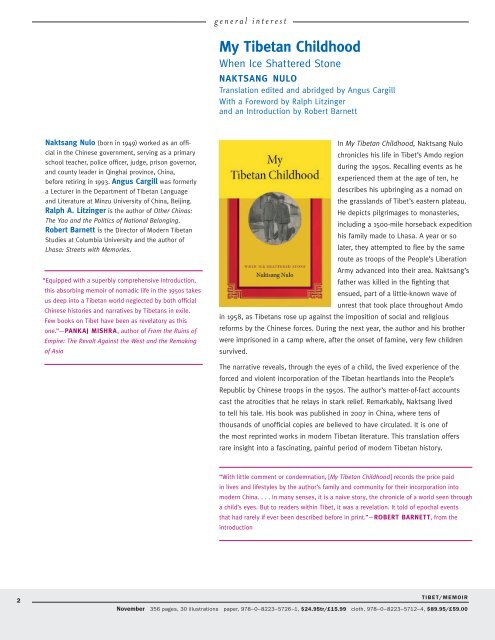x1vuD
x1vuD
x1vuD
You also want an ePaper? Increase the reach of your titles
YUMPU automatically turns print PDFs into web optimized ePapers that Google loves.
general interest<br />
My Tibetan Childhood<br />
When Ice Shattered Stone<br />
naktsang nulo<br />
Translation edited and abridged by Angus Cargill<br />
With a Foreword by Ralph Litzinger<br />
and an Introduction by Robert Barnett<br />
Naktsang Nulo (born in 1949) worked as an official<br />
in the Chinese government, serving as a primary<br />
school teacher, police officer, judge, prison governor,<br />
and county leader in Qinghai province, China,<br />
before retiring in 1993. Angus Cargill was formerly<br />
a Lecturer in the Department of Tibetan Language<br />
and Literature at Minzu University of China, Beijing.<br />
Ralph A. Litzinger is the author of Other Chinas:<br />
The Yao and the Politics of National Belonging.<br />
Robert Barnett is the Director of Modern Tibetan<br />
Studies at Columbia University and the author of<br />
Lhasa: Streets with Memories.<br />
“Equipped with a superbly comprehensive introduction,<br />
this absorbing memoir of nomadic life in the 1950s takes<br />
us deep into a Tibetan world neglected by both official<br />
Chinese histories and narratives by Tibetans in exile.<br />
Few books on Tibet have been as revelatory as this<br />
one.”—PANKAJ MISHRA, author of From the Ruins of<br />
Empire: The Revolt Against the West and the Remaking<br />
of Asia<br />
In My Tibetan Childhood, Naktsang Nulo<br />
chronicles his life in Tibet’s Amdo region<br />
during the 1950s. Recalling events as he<br />
experienced them at the age of ten, he<br />
describes his upbringing as a nomad on<br />
the grasslands of Tibet’s eastern plateau.<br />
He depicts pilgrimages to monasteries,<br />
including a 1500-mile horseback expedition<br />
his family made to Lhasa. A year or so<br />
later, they attempted to flee by the same<br />
route as troops of the People’s Liberation<br />
Army advanced into their area. Naktsang’s<br />
father was killed in the fighting that<br />
ensued, part of a little-known wave of<br />
unrest that took place throughout Amdo<br />
in 1958, as Tibetans rose up against the imposition of social and religious<br />
reforms by the Chinese forces. During the next year, the author and his brother<br />
were imprisoned in a camp where, after the onset of famine, very few children<br />
survived.<br />
The narrative reveals, through the eyes of a child, the lived experience of the<br />
forced and violent incorporation of the Tibetan heartlands into the People’s<br />
Republic by Chinese troops in the 1950s. The author’s matter-of-fact accounts<br />
cast the atrocities that he relays in stark relief. Remarkably, Naktsang lived<br />
to tell his tale. His book was published in 2007 in China, where tens of<br />
thousands of unofficial copies are believed to have circulated. It is one of<br />
the most reprinted works in modern Tibetan literature. This translation offers<br />
rare insight into a fascinating, painful period of modern Tibetan history.<br />
“With little comment or condemnation, [My Tibetan Childhood] records the price paid<br />
in lives and lifestyles by the author’s family and community for their incorporation into<br />
modern China. . . . In many senses, it is a naive story, the chronicle of a world seen through<br />
a child’s eyes. But to readers within Tibet, it was a revelation. It told of epochal events<br />
that had rarely if ever been described before in print.”—ROBERT BARNETT, from the<br />
introduction<br />
2<br />
TIBET/MEMOIR<br />
November 356 pages, 30 illustrations paper, 978–0–8223–5726–1, $24.95tr/£15.99 cloth, 978–0–8223–5712–4, $89.95/£59.00


